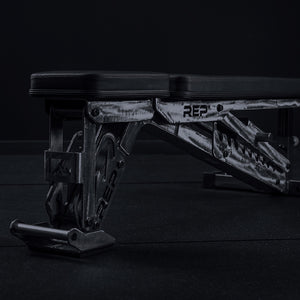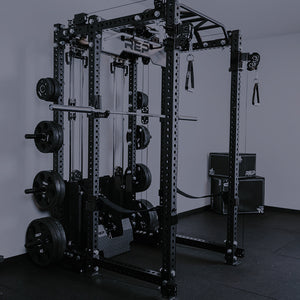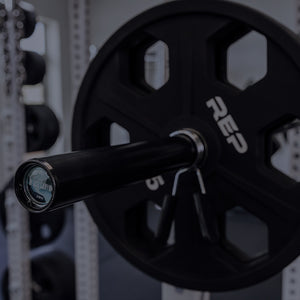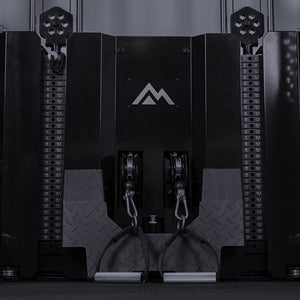
Your most common gym equipment FAQs answered.
You’ve got Qs. We’ve got As.
We’ve heard your questions, and we’ve gotchoo. Here’s our quick answers to your most common gym equipment questions.
Which cable attachment is right for me?

If you are looking to add a cable machine (functional trainer) to your power rack, which one is best for you depends on the following:
What exercises do you want to be able to do on your cable machine?
If you are only looking for basic exercises (such as lat pulldown, seated row, cable curls, tricep pushdowns, glute kickbacks, face pulls, lat pushdowns, front raises, shoulder raises, hip abduction/adduction) with a 1:1 ratio (20lbs on the cable creates 20lbs of resistance – ideal for slower, strength-focused exercises), all you need is a Lat Pulldown and Low Row attachment. You can find selectorized (with a built-on weight stack adjusted by a pin) and plate-loaded (using weight plates to change weight) options for all series of power racks.

If you have a 4000 or 5000 Series power rack and want more functionality – including the lat pulldown and low row option – with the option for unilateral and bilateral exercises, the Ares™ attachment is a better choice. Unlike the lat and low row attachment, this option has a 2:1 ratio, which means 20lbs on the cable creates 10lbs of resistance, best for faster, functional exercises.

If you have a 4000 or 5000 Series rack with more functionality than the basic lat and low row attachment at a lower price point and smaller footprint than the Ares™ attachment, go for the Athena™ attachment. However, the Athena™ attachment (a side-mount functional trainer) does not have the lat and low row components. With the Athena™ attachment, you can choose a left, right, or dual-sided setup. These cables have a 2:1 ratio, which means 20lbs on the cable creates 10lbs of resistance, great for functional exercises.

For more information about how to choose a cable machine, check out this helpful guide.
How do I get a quote for a power rack?
There are several ways to get a quote for your power rack.
- Before doing anything, browse our Rack Guide. Here, you’ll find everything you need to outfit your gym with a power rack, including a dictionary of terms, a walk through the rack selection/purchasing process, how to assemble your rack – everything you need to have total clarity on this exciting purchase.
- If you think you want a 4000 or 5000 Series power rack, you can use our online 3D Rack Builder to build out your dream rack and see how it will look in your space. You can also use the Rack Builder to explore options and the price for the Ares™ attachment and Athena™ attachments.
- Feeling overwhelmed by the Rack Builder? Make it simple by choosing between our various pre-selected power racks. Just select the number of posts, height, depth, color, and a few more details, and we have curated the rest. It’s super simple.
- Need help getting a quote for your power rack? Our customer service team can help you. Streamline this process by knowing your color choice, height, and depth before you talk to a human.
How do I pick the right power rack for the space I have available?
Of course, the first step is determining how much space you have for your gym. Once you know this, you can compare the different power racks (1000 Series, 4000 Series, and 5000 Series). Consider their different functionality/versatility, rackable capacity (how much weight they can handle), as well as growth potential. But if space is a big concern, here’s a quick look at the footprints of the rack (without any additional attachments, such as storage, attachments, cable machines, etc.):
PR-1050 Short Power Rack
72”(H)x58”(W)x48”(D), or 4.8’ wide and 4’ deep

Note: You also need clearance on the sides for the barbell and to load plates. The draw to this particular rack is its shorter height (6’), which can fit in low-ceiling basements and garages and still allow some working space for pull-ups (this rack does have a simple pull-up bar).
PR-1000 Power Rack
83.6”(H)x58”(W)x48”(D), or 4.8’ wide and 4’ deep (the same as the short power rack)

The difference here is this is a full-height rack, at nearly 7’ tall. If you have the ceiling space, this rack has a lot more versatility/compatible attachments without taking up more floor space.
PR-1100 Power Rack
85”(H), 58.1”(W)x48.5”(D), or just slightly more than 4.8’ wide and 4’ deep

This rack is minimally bigger than the PR-1000 and 1.5” taller (7.1’). What distinguishes this from the PR-1000 is the racks are different in width, hole spacing, pull-up bars, and weight storage.
The PR-1000 is wider, with an extra 2” of working space between the uprights. The PR-1000’s holes are closer together; they’re 2”, compared with the PR-1100’s 3” holes. The PR-1100 has a multi-grip pull-up bar, while the PR-1000 offers two separate and different-sized pull-up bars (1.25” in the front and 2” in the back).
And finally, the PR-1000 comes with weight horns on the back base of the rack, while the PR-1100 does not. Overall, the PR-1000 is valued at a slightly higher price because it is a little more stable rack.
Wall-Mount Fixed Rack
80” or 93”(H)x50.8”(W)x16”, 24”, 30”, or 41”(D)

This is a serious space-saving rack, especially if you opt for the 80” (6.7’) height and 16” (1.3’) depth.
The 16” depth and the 24” (4000 Series only) depth four-post racks are great space-saving options. The 30” deep four-post rack is the standard size and most popular. The 41” depth is spacious with plenty of storage space. The deeper rack adds stability to your workouts.
This rack comes in a 4000 or 5000 Series option, which vary by pinhole size and placement, attachment compatibility, and a few other details.
PR-4000 Power Rack
80” or 93”(H)x50.8”(W)x16”, 24”, 30”, or 41”(D)

If you’re limited in space, you can choose to build a half rack. If you have more space, you can go for the largest, 6-post rack.
Still unsure which depth to select? The 16” depth and the 24” depth four-post racks are great space-saving options, with the ability for you to work outside the rack. The 30” deep four-post rack is the standard size and most popular. The 41” depth is spacious with plenty of working space and ideal for lifters with a decent amount of forward lean in their squats.
The deeper rack adds stability to your workouts; bolt it down or add the Rear Base Stabilizer and you don’t have to. However, if you're using the Iso Arms, Spotter Arms, or Globe Pull-Up Bar, you do need to bolt your rack down, even with the Rear Base Stabilizer, regardless of your rack's depth. With those attachments, you also need to add Front Foot Extensions to keep the rack stable.
PR-5000 Power Rack
80” or 93”(H)x50.8”(W)x16”, 30”, or 41”(D)

The PR-5000 comes in three depth options: 16”, 30”, and 41”. The 16” is great for small spaces. The 30” provides plenty of room to work, while still saving space. This rack needs to be bolted down to the floor. The 41” depth offers the most working space for exercises like box squats and adds a lot of stability to the rack.
Of course, if you have shorter ceilings, the 80” height is available for you.
The main difference between the PR-5000 and PR-4000 is the PR-5000 has more attachment compatibility than any other power rack. In addition, the PR-4000 has laser-cut numbers every five holes. The PR-5000 has laser-cut numbers on every hole, making it extra easy to line up attachments.
In addition, the PR-4000 rack’s pinholes are 5/8”. It has 1” hole spacing throughout the bench zone and 2” elsewhere for a precise liftoff height. The PR-5000 has 2” hole spacing throughout with 1” pinholes. On the PR-5000, you can achieve 1” hole spacing on the entire rack with our Lowered J-cups.
How many stall mats do I need for my gym space?

REP offers two different types of floor mats (or stall mats): 3x4’ tiles and a 4x6’ option.
The 3x4’ stall mats come in a package of five mats or 10 mats. These cover 12SQFT per tile. The five pack will cover 60SQFT total. The 10 pack will cover 120SQFT total.
The 4x6’ mats have a minimum order of three up to, well, a lot. The price per mat drops the more you get. These cover 24SQFT per tile.
You can also go for Rubber Floor Tiles, which are a little less tough/lighter weight than the stall mats and lock together like a puzzle, rather than lying side by side. These come in sets of four. They are 24”(L)x24”(W) (so, 2’x2’) and 38” thick. They cover 4SQFT per tile. This equates to 16SQFT total per set of four.
So, how many do you need? Check the square footage of your power rack, for starters. But you want some extra working space on the sides of your rack, too. Instead of selecting mats based on your rack size, select flooring based on how much space you can dedicate to your home gym. That’s going to depend on your individual setup.
Unsure how to determine square feet of your room?
Hey, we don’t judge! Measure the length and width of your space. Now, multiply the length by the width. So, if you have a space that is 12’ long and 10’ wide, the square feet would be 120’. Divide this number by the square feet of the tile style of your choice. So, if you want 3x4’ stall mats, you would divide 120’ by 12SQFT (10 tiles). If you want 4x6’ stall mats, you would divide 120 by 24 (5 tiles). And if you want the rubber tiles, you’d divide 120 by 4 to determine how many tiles you need (30 tiles).
Do the 80” racks have the same functionality as the taller versions?
Yes, the 80” racks have the same functionality as the 93” racks. However, there is less range of motion on attachments like ISO Arms. The height of the shorter rack may limit what exercises you can do on the rack, the number of attachments you use, and which attachments you select. In addition, taller lifters may have limitations to some movements on the shorter rack (the 80” rack is 6.7’ tall).
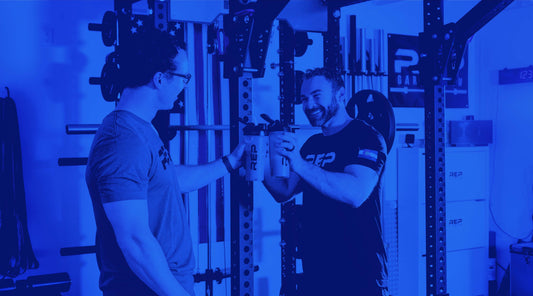
NEWSLETTER SIGNUP
Product launch information, promotions, blogs, and REP news.

